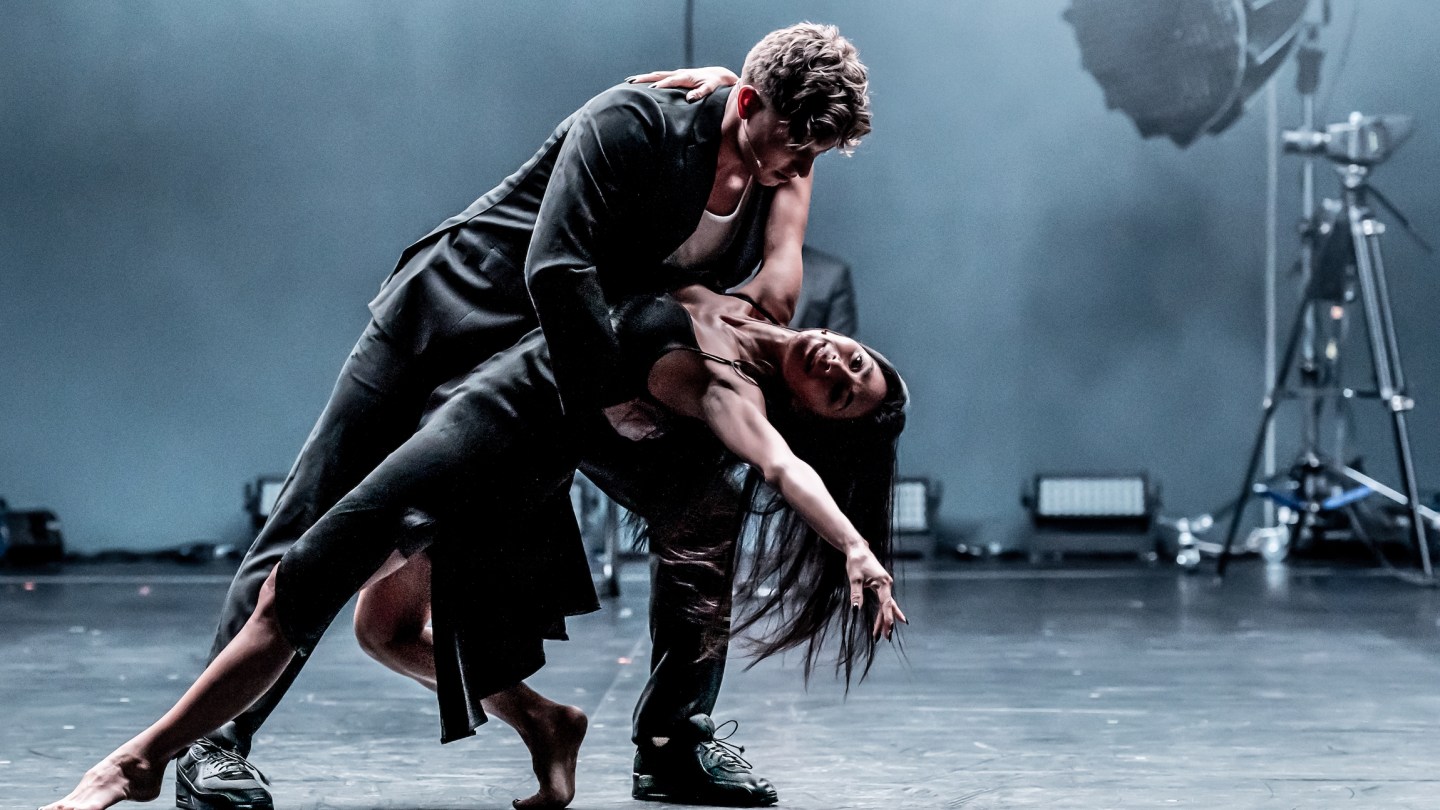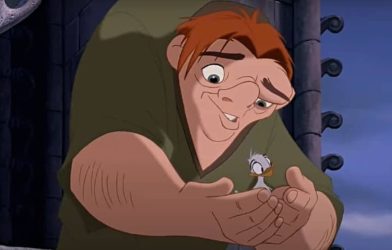When Andrew Lloyd Webber’s stage adaptation of the 1950 Billy Wilder film Sunset Boulevard premiered in London in 1993 and on Broadway the following year, it was arguably the last gasp of the ‘80s megamusical aesthetic — at least until shows like The Lion King and Wicked came along to tweak the formula. The success of blockbusters like Cats, Les Misérables, The Phantom of the Opera and Miss Saigon was driven as much by their large-scale spectacle as their musical craftsmanship. Probably more.
Audiences flocked to Cats for its then-revolutionary immersive junkyard staging and the climactic ascent to the heavens of faded feline Grizabella on an outsized tire. In Les Mis, it was the massive turntable and the big reveal of the Paris Uprising barricade. Phantom brought a huge chandelier crashing down on the stage and Miss Saigon flew in a helicopter to evacuate the last Americans at the end of the Vietnam War.
With Sunset, it was the gasp-inducing staircase. Dominating the decaying splendor of Norma Desmond’s mansion, the ornate structure was designed for the grand entrance of that erstwhile star of the silent screen, as well as her ultimate descent into madness. Stars including Patti LuPone, Glenn Close and Betty Buckley have wound their way down those stairs, dressed in bejeweled finery that evoked Salome, the doomed princess Norma dreamed of playing in a delusional comeback vehicle.
That opulent history made the musical an out-of-left-field choice for British director Jamie Lloyd, known for bare-bones minimalist, bracingly modern productions that strip away sets and props to excavate the dramatic core of the text with piercing clarity. The most celebrated of them — on both sides of the Atlantic — include Betrayal with Tom Hiddleston, A Doll’s House with Jessica Chastain and Cyrano de Bergerac with James McAvoy.
So how does Sunset Blvd., as the show is titled here, hold up without all the gilded grandeur that allowed Norma to remain locked inside her fantasy of eternal stardom? Magnificently, it turns out. Despite a few full-ensemble numbers of varying effectiveness, Lloyd has chiseled what was once a behemoth into a chamber musical for four characters, ingeniously designed in atmospheric black and white, like the Wilder film, until murder bathes the stage in blood red.
I’ll confess I’ve always thought of Sunset Boulevard as a second-rate musical elevated by a couple of great songs and by the glorious scenery-chomping opportunities it affords its leading ladies. This is the first time I’ve really considered it as a searing tragedy with something to say to contemporary audiences. Its reflections on the cruelty of aging and obsolescence, the addictive allure of fame, the currency of youth and beauty and the sad refuge of madness have never carried such sting.
Lloyd Webber’s lush score is well-served by a cast of uniformly strong singers, and the book by Don Black and Christopher Hampton captures the ghoulish darkness of the movie. But this production belongs to the director and his star.
The headline news of Lloyd’s revival, which comes to Broadway after sweeping the Olivier Awards in its London run, is Nicole Scherzinger’s sensational turn as Norma. Many wondered if the performer, made famous by early 2000s girl group the Pussycat Dolls, was too young, or if she had the stage presence and acting chops for the role. But those concerns vanish almost from the moment she’s hoisted by the chorus into the spotlight during Lloyd’s amusing live-capture opening credits, just as the title appears in the boldest of red fonts.
Gloria Swanson was 50 when the film was made and Scherzinger is 46, which tracks accurately for a show set in 1949 about a woman who got her start in silent movies at 16. Just as Swanson’s own history as a young star in pre-talkies Hollywood played into her characterization, there’s poignant subtext in the casting of Scherzinger, who has aged out of mainstream pop — though in her case, musical theater might be her true calling.
Scherzinger’s roof-raising vocal power, especially on the musical’s signature songs, “With One Look” and “As If We Never Said Goodbye,” is astonishing, literally stopping the show with her soaring money notes and dramatic key changes. She’s the rare Norma who has the supple dance moves, too. Her command is never in doubt, and Lloyd provides unimpeded access to her every emotion by frequently giving Norma what she craves most — a camera and a closeup.
Rigged on a frame that does occasional double duty as a steering wheel, those cameras are operated by chorus members and principals alike. While Scherzinger is mesmerizing when she’s prowling like a panther, barefoot and wearing a simple black satin slip throughout, the moments in which we watch her performance in duplicate — live onstage, looking straight into the camera, and splashed in black and white on the giant, tilted rear screen — have a scorching intimacy.
Her Norma has the melodramatic largeness of the silent era — eyes blazing, fingers splayed and arms held so tautly we see every sinew. But there’s also a rich vein of sardonic humor and camp. That aspect recedes as the pathos creeps in, gradually building to an unhinged crescendo. As she’s driven to murder, the star’s long sheath of black hair makes her appear like a possessed woman right out of J-horror.
The victim of that homicide, for the TCM-averse who have never seen the brilliant Wilder film, is unemployed screenwriter Joe Gillis. That’s no spoiler, given that the movie opened with William Holden floating face-down, dead in Norma’s swimming pool, while Lloyd starts the show with Tom Francis’ Joe unzipping himself from a body bag. He promises to tell us “the real story,” not the version splashed over the tabloids.
The excellent Francis — who like all four principals is reprising his role from London — finds an ideal balance between Joe’s cynical opportunism and his charm. In a way, he’s hardly worse than emotionally manipulative Norma, who’s always ready with a suicide attempt to ensure that she keeps her kept man.
Joe is at a professional dead end, unable to get a project off the ground and too disillusioned to take up the offer of smart young script editor Betty Schaefer (Grace Hodgett Young, enchanting) to collaborate on an adaptation of one of his short stories. He’s fleeing loan sharks when his car careens into the garden of Norma’s mansion, where she and her devoted butler Max (David Thaxton, what a voice!) are about to bury her pet chimp, and mistake him for an undertaker.
One mention of Joe’s profession and Norma seizes on the idea of having him help hone her epic script of Salome. Despite knowing the project will never see the light of day, Joe is persuaded by the smell of easy money. Before he knows what’s happening, Max has moved his possessions into a room above the garage. Norma’s interest in Joe quickly escalates to love; she has him moved into the main house and outfitted in sharp new threads before sweeping him across the floor in a tango at a New Year’s Eve party during which he learns he’s the only guest.
By cutting two disposable songs, “The Lady’s Paying” and “Eternal Youth Is Worth a Little Suffering,” Lloyd intensifies the focus on the fraying strands of what’s left of Norma’s sanity. She makes what in her head is a regal return to the Paramount lot to meet Cecil B. DeMille (Shavey Brown, seen only as a silhouetted closeup on the screen) and, despite his evasive responses about the script Max delivered a week earlier, comes away convinced she’ll soon be back in front of the cameras.
Jack Knowles’ lighting — often peering through clouds of smoke — is ravishingly moody throughout, notably his arresting use of period-style pin spots that cast dramatic shadows. But the most visually striking sequence is when Norma steps onto the soundstage where DeMille is shooting and is instantly transported. When an unseen crew member high up on a camera crane recognizes her from the old days, she’s bathed in a golden spotlight made even more dazzling by the show’s predominantly monochromatic design.
Scherzinger’s rapturous performance of “As If We Never Said Goodbye” heightens that magical moment, building to a shattering climax on the line “I’ve come home at last.” You might roll your eyes at the vocal showboating of holding the note for what seems an impossibly long time on the word “home,” but it’s undeniably effective, generating huge mid-song applause.
Norma’s imagined triumph puts her on a higher perch from which to fall, her unraveling hastened by the discovery that Joe has begun sneaking out to see Betty and work on their script. Betty is romantically involved with Joe’s best friend Artie (Diego Andres Rodriguez), but when her affections shift to Joe, he has even more incentive to free himself from Norma’s possessive clutches.
Having Scherzinger stand stock-still center stage through all this — including Max’s explanation to Joe of his selfless loyalty and years of deception to make the mistress of the house believe her fans have never abandoned her — makes Norma a witness to her own humiliation.
Lloyd’s staging of the ensemble numbers is less convincing than the more intimate songs, and Fabian Aloise’s choreography can get a bit hyperactive, like a mashup of A Chorus Line and West Side Story. While the panic of the closing scenes fits with the swerve into fever-dream horror, it becomes distractingly frantic, with the principals doing diagonal dashes back and forth across the stage like track competitors.
The choreography works better in haunting moments featuring the young Norma (Hannah Yun Chamberlain), who — in an expressive device borrowed from Follies — stalks the stage like a ghost, occasionally breaking into Salome’s “Dance of the Seven Veils.”
A sequence already much talked about expands on an idea at the end of Lloyd’s A Doll’s House by taking the action outside the theater, also recalling Ivo van Hove’s video-saturated Network. As intermission ends and the orchestra strikes up, Francis winds his way, on camera, around the labyrinthine backstage corridors and stairs, peeking into his co-stars’ dressing rooms.
There are silly but fun sight gags — Thaxton spellbound by a Pussycat Dolls promotional shot tacked to his mirror; a life-size Andrew Lloyd Webber cutout; someone in a chimp suit; a pair of chorus boys making out; Scherzinger scrawling “Mad about the boy” on her mirror in lipstick. Those winking meta touches echo other period departures, like anachronistic dance moves, the ensemble’s contemporary streetwear or the laptop on which Joe and Betty’s script takes shape, a Jamie Lloyd Company coffee mug sitting alongside it.
Theater and film converge to brilliant effect at the start of Act II, when Joe throws open a door and steps out onto 44th Street. He launches into the title song, an embittered screed about the Hollywood dream factory, as he strides past Sardi’s and around the corner onto Shubert Alley before doubling back and hitting the stage on the final note.
That virtuoso camera choreography, taking in a prime stretch of Broadway real estate, seems to suggest that showbiz glory can be equally fickle in any medium. As Norma watches all this on the screen, we can almost see the cracks forming in her illusory world.
Venue: St. James Theatre, New York
Cast: Nicole Scherzinger, Tom Francis, Grace Hodgett Young, David Thaxton, Diego Andres Rodriguez, Hannah Yun Chamberlain, Shavey Brown
Music: Andrew Lloyd Webber
Book and lyrics: Don Black, Christopher Hampton
Director: Jamie Lloyd
Set and costume designer: Soutra Gilmour
Lighting designer: Jack Knowles
Sound designer: Adam Fisher
Video designer-cinematographers: Nathan Amzi, Joe Ransom
Orchestrations: David Cullen, Andrew Lloyd Webber
Music direction: Alan Williams
Choreographer: Fabian Aloise
Presented by The Jamie Lloyd Company, ATG Productions, Michael Harrison for Lloyd Webber Harrison Musicals, Gavin Kalin Productions









